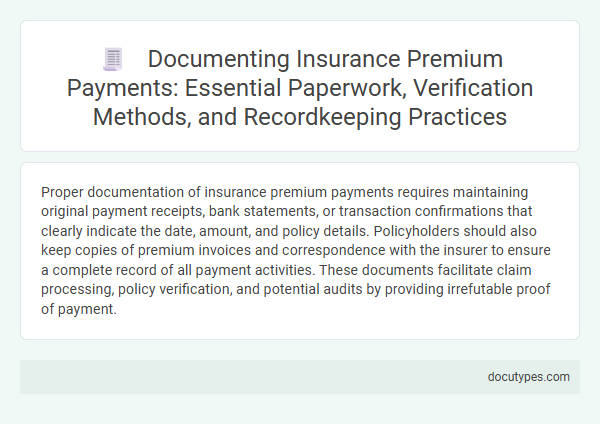Proper documentation of insurance premium payments requires maintaining original payment receipts, bank statements, or transaction confirmations that clearly indicate the date, amount, and policy details. Policyholders should also keep copies of premium invoices and correspondence with the insurer to ensure a complete record of all payment activities. These documents facilitate claim processing, policy verification, and potential audits by providing irrefutable proof of payment.
Understanding Insurance Premium Payments
What paperwork is necessary for documenting insurance premium payments? Insurance premium payments require proper documentation to ensure accurate record-keeping and proof of payment for policyholders and insurers. Receipts, bank statements, and payment confirmation emails serve as essential documents for verifying transactions.
Essential Documents for Premium Payment Proof
Documenting insurance premium payments requires maintaining essential paperwork to verify payment accuracy and timeliness. These documents serve as proof for both policyholders and insurers during claims or audits.
Key documents include payment receipts, bank statements, and canceled checks that clearly show the amount and date of the premium paid. Policyholders should also retain insurance policy schedules and premium notices to cross-reference payment details.
Accepted Methods of Premium Payment Verification
Accepted methods of premium payment verification typically include bank statements, credit card receipts, and canceled checks. Insurance companies may also require electronic payment confirmations through their online portals or payment apps. Maintaining copies of these documents helps ensure accurate record-keeping and smooth claim processing.
Digital vs. Physical Documentation: Pros and Cons
Documenting insurance premium payments requires accurate records to ensure proof of payment and policy validation. Both digital and physical documentation methods present unique advantages and challenges in managing insurance records.
- Digital Documentation Advantages - Digital records allow easy access, quick retrieval, and secure cloud storage for insurance premium payment proofs.
- Physical Documentation Benefits - Paper receipts and printed statements provide tangible evidence that is straightforward to file and review without technical resources.
- Challenges in Digital Documentation - Risks include data breaches, accidental deletion, and dependence on technology for accessing premium payment proofs.
- Challenges in Physical Documentation - Physical papers can be lost, damaged, or disorganized, making it difficult to verify past payments efficiently.
Organizing and Storing Insurance Payment Records
| Document Type | Description | Importance for Insurance Premium Payments |
|---|---|---|
| Payment Receipts | Proof of each insurance premium payment made, including date, amount, and method of payment | Essential for verifying timely payments and resolving disputes with insurance providers |
| Bank Statements | Records showing transactions related to insurance premium withdrawals or payments | Supports verification of payments when receipts are unavailable or unclear |
| Premium Payment Schedules | Documentation outlining the due dates and amounts of insurance premiums | Helps track upcoming payments and manage cash flow |
| Policy Documents | The insurance contract that specifies premium amounts, coverage periods, and billing details | Reference for confirming the correctness of payment amounts and schedules |
| Electronic Payment Confirmations | Emails or digital receipts confirming online or app-based premium payments | Immediate proof of payment, crucial for digital payment methods |
| Organizing System | Filing methods such as physical folders, digital folders, or specialized apps for record keeping | Ensures premium payment documentation is easy to access and systematically stored |
Organizing and storing insurance premium payment records in a structured manner is critical. Maintaining clear, accessible records assists in managing Your insurance portfolio efficiently and resolving any payment discrepancies swiftly. Implement a consistent filing system to preserve all essential paperwork related to premium payments.
Best Practices for Recordkeeping Compliance
Accurate documentation of insurance premium payments is essential for compliance and financial tracking. Key paperwork includes payment receipts, premium invoices, and bank statements.
Maintain organized records by consistently filing all payment documents chronologically. Use digital tools to scan and store copies securely for easy retrieval during audits. Regularly reconcile payments with insurance statements to ensure accuracy and detect discrepancies early.
Handling Discrepancies in Premium Payment Records
Accurate documentation of insurance premium payments is essential for maintaining clear financial records and ensuring policy validity. Key paperwork includes payment receipts, bank statements, and official premium invoices from the insurer.
Handling discrepancies in premium payment records requires prompt verification against original documents and insurer records. Policyholders should report inconsistencies immediately and retain all correspondence for resolution purposes.
Timeframes for Retaining Payment Documentation
Insurance premium payments require proper documentation to ensure accurate record-keeping and proof of payment. Receipts, bank statements, and confirmation emails serve as essential paperwork for verifying transactions. Retain these documents for at least three to seven years, as insurers and regulatory bodies may request them during audits or claims assessments.
Protecting Sensitive Payment Information
Proper documentation of insurance premium payments is crucial for accurate record-keeping and policy validation. Safeguarding sensitive payment information prevents fraud and ensures compliance with privacy regulations.
- Payment Receipts - Detailed receipts verify the date, amount, and method of each premium payment made.
- Secure Storage - Payment records should be stored in encrypted digital formats or locked physical files to protect sensitive data.
- Access Controls - Limiting access to payment documentation to authorized personnel reduces the risk of unauthorized information disclosure.
Maintaining organized, secure paperwork helps protect clients' financial details while supporting accurate insurance premium tracking.
What Paperwork Is Necessary for Documenting Insurance Premium Payments? Infographic

